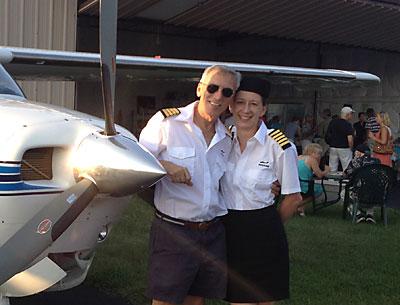Across the Atlantic, One Hop at a Time

“Fire! There’s a fire!” someone yelled out at Dr. Eugene Z. Haller’s going-away party at East Hampton Airport on Saturday. Dr. Haller, a chiropractor, excused himself from a conversation after he realized all the shouting wasn’t just a poor attempt at humor, or double-entendre.
“Who did this?” he asked, smiling as he hosed off a flaming sofa.
Two days after the party, Dr. Haller took off in his single-engine airplane on an overseas journey from East Hampton to Budapest.
Lindbergh’s trans-Atlantic flight this was not. “This is a fun trip,” said Dr. Haller, who was accompanied by his longtime girlfriend, Ina Mehlig, who lives in Munich. “We’re touring. No set schedule.” Dr. Haller, a 35-year East Hampton resident who has been flying for just as long, described the trip as “a culmination of my skills as a pilot.”
The couple will make seven scheduled stops to refuel and sightsee: Quebec City, Quebec; Goose Bay, Newfoundland and Labrador, and Narsarsuaq, Greenland (considered one of the world’s most dangerous airports, with the approach through a fjord necessitating a 90-degree turn to line up with the runway and a risk of icebergs drifting into the arrival path).
Also, Reykjavik Iceland, Wick, Scotland, the Champagne and Bordeaux regions in France, Munich, and Budapest, where Dr. Haller will visit with family. As wine-lovers, the couple look forward especially to their time in France.
On a typical travel day, Dr. Haller said his non-pressurized, non-turboprop 1977 Cessna 210 might cover 771 miles at altitudes below 17,000 feet, which takes four to five hours at 160 knots. “It cost me $600 to fill the tank this morning,” he said. The Cessna has logged more than 5,000 hours.
“There’s always a certain level of danger in an aircraft, or a car, or walking down the street,” said the pilot, who prefers to “hand-fly” his plane rather than cruise on auto-pilot. “The plane doesn’t know whether it’s over the ocean, the sound, or land, so concentration, proper planning, and risk-mitigation are imperative.”
In preparation for their 5,000-mile-plus trek, the couple completed an “aircraft ditching course” in Groton, Conn., an eight-hour survival class that teaches appropriate response to on-board emergencies and aircraft-ditching procedures, as well as sea survival simulations.
“We’ve got immersion suits,” the protective one-piece garments designed to provide protection in cold water, Dr. Haller said. “Hypothermia is often the reason why people don’t make it.”
Dr. Haller’s most harrowing experience in an airplane wasn’t in the air at all. “I hit a deer on the runway right there,” he said, pointing off into the distance. “If I’d accelerated a couple seconds sooner, damage could have been unthinkable.” Since then, the doctor has been a proponent of deer fence improvements at East Hampton Airport. “Why would you have a fence with holes in it?” he asked.
It seemed as though every reveler at Saturday’s party had a story to tell about a trip they’d taken with Dr. Haller in his six-person Cessna. “We used to take off from here, hit the slopes in Vermont, and be back in time for dinner,” one person said. “We’d party-hearty in Panama and the Caribbean,” said another.
“If anyone can do this trip, it’s Eugene,” said Michael Myers, the plane’s mechanic.
“This will be a very special trip,” said Ms. Mehlig, a midwife who met Dr. Haller on a Royal Clipper cruise six years ago. Asked whether she would be with Dr. Haller on the return trip, she replied, “No way. I’m staying in Germany.”
Speaking of the flight back, in November, Dr. Haller said he was considering a Southern Hemisphere route, through Africa. “It will be spring there,” he said.
